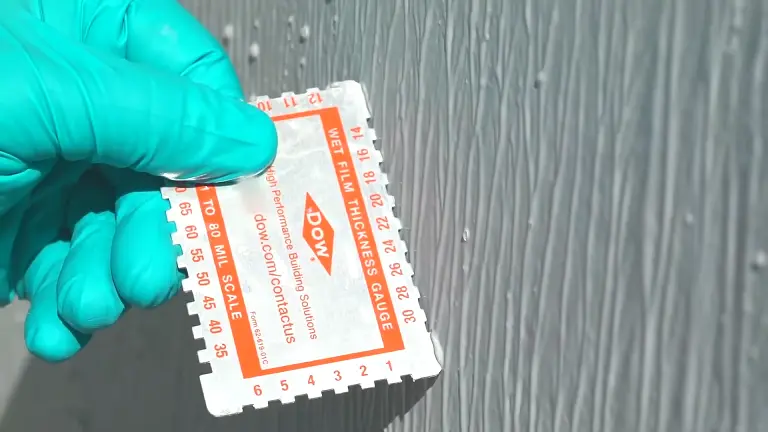A Mil Thickness Gauge measures the thickness of coatings or materials in mils. One mil equals one-thousandth of an inch.
Mil Thickness Gauges are essential tools in various industries, including automotive, manufacturing, and construction. They ensure that coatings like paint, varnish, or epoxy meet specified thickness requirements, which is crucial for performance and durability. These gauges come in different types, such as mechanical, digital, and ultrasonic, each offering unique benefits.
Accurate measurement helps in quality control, compliance with standards, and cost efficiency. Proper usage of a Mil Thickness Gauge enhances product longevity and reduces the risk of defects. Investing in a reliable gauge is vital for achieving precise and consistent coating thickness.
Mil Thickness Gauge Basics
A Mil Thickness Gauge is an essential tool for measuring material thickness. It ensures accuracy in various applications, from painting to coating.
What Is A Mil?
A mil is a unit of measurement. One mil equals one-thousandth of an inch (0.001 inches). This unit is used to measure thickness. It is common in industries like painting and coating.
Understanding mils helps in achieving the right thickness. This is crucial for both performance and durability.
How Thickness Gauges Work
Thickness gauges measure material thickness in mils. They use various methods, such as mechanical or electronic.
Mechanical gauges use physical contact. A probe touches the material and displays the thickness.
Electronic gauges use sensors. These sensors provide more precise readings. They are often used for non-destructive testing.
| Type of Gauge | Method | Usage |
|---|---|---|
| Mechanical | Contact | General |
| Electronic | Sensor | Precise |
Choosing the right gauge depends on your needs. For more precision, electronic gauges are better.
Types Of Mil Thickness Gauges
Choosing the right mil thickness gauge is crucial for accurate measurements. There are two main types: Mechanical Gauges and Digital Gauges. Each has its unique features and benefits.
Mechanical Gauges
Mechanical gauges are known for their durability and simplicity. They are perfect for rough environments where electronic devices might fail.
- Dial Indicators: These gauges use a dial to display measurements. They are easy to read and very reliable.
- Micrometers: These provide high precision and are great for detailed measurements. They are often used in industrial settings.
- Calipers: Versatile and can measure inside, outside, and depth dimensions. They are available in various sizes.
Digital Gauges
Digital gauges offer advanced features and higher accuracy. They are user-friendly and provide quick readings.
- Digital Micrometers: These provide exact readings on an LCD screen. They are ideal for precise applications.
- Digital Calipers: They offer multi-functional capabilities with digital readouts. They can store data for further analysis.
- Laser Thickness Gauges: These use laser technology for non-contact measurements. They are perfect for sensitive surfaces.
| Type | Features | Best For |
|---|---|---|
| Dial Indicators | Simple, durable | Rough environments |
| Micrometers | High precision | Industrial use |
| Calipers | Versatile | Various measurements |
| Digital Micrometers | Exact readings | Precise applications |
| Digital Calipers | Multi-functional | Data storage |
| Laser Thickness Gauges | Non-contact measurements | Sensitive surfaces |
Key Features To Consider
Choosing the right Mil Thickness Gauge involves understanding key features. These features ensure you make an informed decision. Below are some crucial aspects to keep in mind.
Accuracy And Precision
Accuracy and precision are vital for any Mil Thickness Gauge. A gauge must provide consistent readings. Look for a device with a low margin of error. Consistent readings ensure reliable measurements.
Check the specifications for tolerance levels. A tighter tolerance means better accuracy. Make sure the gauge has been tested for accuracy. Reliable brands often display their accuracy ratings.
Ease Of Use
An easy-to-use gauge saves time and effort. Look for a model with a clear display. A large, digital readout is easier to read. Simple buttons and a user-friendly interface are essential.
Consider the device’s size and weight. A lightweight gauge is easier to handle. Ergonomic designs reduce strain during prolonged use. A compact model is convenient for storage and transport.
Here is a table summarizing key features for ease of use:
| Feature | Benefit |
|---|---|
| Clear Display | Easy to read measurements |
| Simple Interface | User-friendly operation |
| Lightweight Design | Reduces handling strain |
| Compact Size | Convenient storage |
Applications In Various Industries
The Mil Thickness Gauge is a versatile tool. It measures the thickness of coatings and materials. Various industries use it to ensure quality and precision. Below are some key applications in different sectors.
Automotive Industry
The automotive industry relies on the Mil Thickness Gauge for several applications. It helps in measuring paint thickness on vehicles. This ensures an even coating, which is vital for protection and aesthetics.
- Quality Control: Inspect paint thickness on cars and trucks.
- Safety: Ensure uniform coatings to prevent corrosion.
- Aesthetics: Maintain a consistent appearance.
| Application | Importance |
|---|---|
| Paint Thickness | Ensures even coating. |
| Rust Prevention | Prevents corrosion. |
| Appearance | Maintains visual appeal. |
Manufacturing Sector
The manufacturing sector also benefits from the Mil Thickness Gauge. It is crucial for measuring the thickness of various coatings and materials. This ensures products meet industry standards.
- Product Quality: Ensures materials meet specifications.
- Durability: Verifies protective coatings are adequate.
- Compliance: Confirms adherence to industry regulations.
The Mil Thickness Gauge is essential in many manufacturing processes:
- Metal Coatings: Ensures protective layers are applied correctly.
- Plastic Coatings: Verifies thickness for durability.
- Paint Layers: Confirms even application.

How To Use A Mil Thickness Gauge
A Mil Thickness Gauge is an essential tool for measuring coating thickness. Accurate measurements ensure quality and durability. This guide will teach you how to use it properly.
Step-by-step Guide
- Prepare the Surface: Ensure the surface is clean and dry.
- Calibrate the Gauge: Calibrate the device according to the manufacturer’s instructions.
- Place the Gauge: Position the gauge on the coating surface.
- Read the Measurement: Note the reading displayed on the gauge.
- Record the Data: Write down the measurement for future reference.
Common Mistakes To Avoid
- Skipping Calibration: Always calibrate before measuring.
- Improper Surface Prep: Clean and dry the surface completely.
- Incorrect Gauge Placement: Place the gauge flat on the surface.
- Ignoring Environmental Factors: Avoid extreme temperatures and humidity.
Using a Mil Thickness Gauge accurately ensures the quality of your coatings. Avoid these common mistakes for precise measurements every time.
Maintenance And Calibration
Proper maintenance and calibration of your mil thickness gauge ensure accurate readings. Regular upkeep extends the device’s lifespan, saving costs in the long run. Below, we provide essential tips and procedures.
Routine Maintenance Tips
Regular maintenance keeps your mil thickness gauge in top condition. Follow these tips:
- Clean the gauge after each use.
- Store it in a dry, cool place.
- Check for any visible damage.
- Ensure the battery is always charged.
- Use a soft cloth to wipe the screen.
Inspect the probe and connectors regularly. Replace any worn-out parts. This ensures accurate readings every time. Keeping the gauge clean and dry prevents corrosion.
Calibration Procedures
Calibration is crucial for accuracy. Follow these simple steps:
- Turn on the mil thickness gauge.
- Select the calibration mode.
- Use a standard calibration sample.
- Place the probe on the sample.
- Adjust the reading to match the sample value.
- Save the calibration setting.
Repeat this process for different measurement ranges. Perform calibration monthly or after heavy use. Always use certified calibration samples for best results.
Benefits Of Using A Mil Thickness Gauge
A Mil Thickness Gauge is an essential tool for measuring coating thickness. It offers many benefits across various industries. Accurate measurements ensure product quality and save costs.
Quality Control
The Mil Thickness Gauge enhances quality control by providing precise measurements. This ensures coatings meet the required standards and specifications. It helps in identifying defects and inconsistencies early.
Consistent coating thickness ensures product durability and performance. This tool helps maintain uniformity in production processes. It is essential for industries like automotive, construction, and manufacturing.
Cost Efficiency
Using a Mil Thickness Gauge can significantly improve cost efficiency. Accurate measurements reduce material wastage. This helps in using the exact amount of coating needed.
| Benefit | Description |
|---|---|
| Reduced Wastage | Accurate measurements minimize excess material use. |
| Improved Efficiency | Ensures optimal use of resources. |
| Cost Savings | Less wastage leads to lower production costs. |
By ensuring the correct thickness, fewer reworks are needed. This leads to faster production times and lower labor costs. Businesses can save money and increase profitability.
Choosing The Right Gauge For Your Needs
Picking the right mil thickness gauge is crucial. It ensures you get accurate measurements for your materials. With many models available, it’s vital to know your requirements first. This guide will help you make an informed choice.
Assessing Your Requirements
Start by understanding your specific needs. Are you measuring thin films or thick coatings? Knowing this will help you choose the correct gauge range.
Consider the following:
- Material Type: Different materials need different gauges.
- Accuracy: High precision is essential for some projects.
- Frequency of Use: Frequent use might need a durable gauge.
- Budget: Determine how much you are willing to spend.
Each of these factors plays a key role in your decision-making process.
Top Models On The Market
Here’s a quick overview of some popular mil thickness gauges:
| Model | Features | Price Range |
|---|---|---|
| Model A | High precision, digital display, durable | $$$ |
| Model B | Portable, easy to use, good for thin films | $$ |
| Model C | Budget-friendly, basic functionality | $ |
Each model offers unique features suited for different tasks. Choose one that matches your needs and budget.
By assessing your requirements and knowing the top models, you can select the best mil thickness gauge for your projects.
Frequently Asked Questions
What Is A Mil Thickness Gauge?
A mil thickness gauge measures the thickness of coatings. It is crucial for ensuring material uniformity and quality.
How Does A Mil Thickness Gauge Work?
A mil thickness gauge uses magnetic or ultrasonic technology. It measures the distance between the coating surface and the substrate.
Why Use A Mil Thickness Gauge?
Using a mil thickness gauge ensures coating consistency. It helps in quality control and adherence to industry standards.
What Materials Can It Measure?
A mil thickness gauge can measure coatings on metal, plastic, and wood. It is versatile and widely used.
Conclusion
Understanding mil thickness gauges is crucial for accurate measurements. They ensure product quality and compliance with industry standards. Investing in a reliable gauge can boost efficiency and reduce errors. Make informed choices and enhance your processes with the right tool.
Stay ahead in your field with precise measurement technology.

